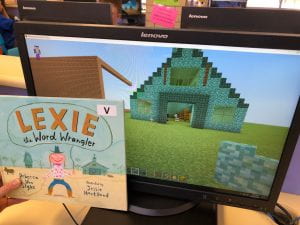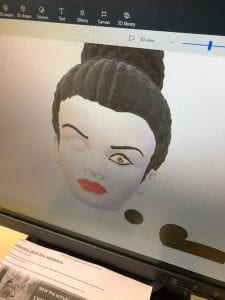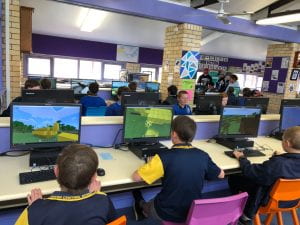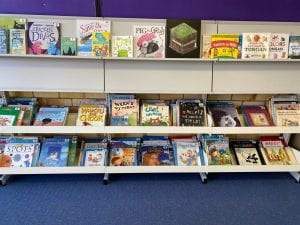How did all the Teacher Librarians I ever met make all this look so effortless? As I reflect back on my journey so far I can see hurdle after hurdle and most of them are knocked over rather or run around rather than successfully cleared. I have learned so much, more than I had expected but I feel I still have so much more to go. Experience is a great teacher but so too are other people going on the same journey. I could not have done this course without the support and wisdom of many others.
The Three main areas I want to focus on in my reflection are ICT in the library, Building community and Library management. I would not claim to have been a roaring success in any of these areas but I have definitely grown as a professional and can see the path I need to be on.
ICT in the library
When I started my position I was only working with K-6. 3-6 were clearly capable users of technology and had plenty of skills. K-2 rarely had access to technology and it showed. This was not the fault of the teachers, the bizarre booking system the school uses for the laptops that live in the library generally sees infants classes prevented from using the devices. Teachers were grateful when I explained I planned to incorporate ICT into most library lessons.
I had a win very early on when I introduced minecraft education edition to the school. Licenses were provided for all students and lessons were exciting. Sadly teachers would walk in and see students “playing” and questioned the educational value. I had to talk an angry executive through my lessons only to have them light up at my integration of literature computers. STEMT4L Robotic and VR kits were also wonder ways to inspire students.

Figure 1 Creating a minecraft world based on a picture book
When Co-vid19 closed schools I was completing Digitial Citizenship in schools. This was probably the course with the biggest impact me at the time due to the fact it coincided with remote learning. It was also one of the most frustrating because I was learning things that could be useful but never got the chance to put it into practice because being “The Librarian” meant I had “nothing” to do so I was attached to Primary and had to add to their google classrooms in their way.
I missed having my own class where I could innovate and put everything into practice my own way.
As I said in my blogpost on June 1st 2020
“As I sit here typing this reflection I find myself torn between regret and anger. Regret because I should have ignored the usual politics of ‘the exec will handle this and tell you what to do’ and stood up and said “Hey, I actually know a bit about this”.”
I know I need to find my voice as a librarian and this is one thing I keep coming back to in every reflection for every subject.
The other aspect of this course that I learned a lot from that I wasn’t expecting was the collaboration and the way we meshed together so well. I was in awe of these women who had families and multiple jobs and made it all fit when I was struggling to plan lessons and turn up for our zooms. We had different perspectives but made them fit together so well. It was by far my most satisfying academic experience to date.
As a result of the learning I did in this course I was able to adapt my delivery of library lessons. When Schools reopened I was also given a 7-10 load and quickly put the Digital Learning environments I had learned about to good use. I was also able to pass on skills I had picked up my students are now all users of powtoon and canva and many have used these in assignments for other teachers. That is what I think is important. They haven’t just learned what they need to get through my lesson but they have taken that information and applied it to their next challenge. This is what a librarian is meant to facilitate.
I believe ICT based tasks need to be authentic and not just done for the sake of using the technology. Research (Drossel et-al, pp568-569, 2017) supports my opinion but also states that teacher attitude can impact on the success of ICT lessons too. I think an aspect of my teaching style that helps here is I am never worried about doing something wrong in front of students and will actively seek their suggests when things go wrong.
A recent example of creating authentic lessons that was highly successful, far more than I expected, was showing students how to use the Trove and state land record websites to research past events and the people involved. I explained if they were asked to talk about Guyra 100 years ago for instance instead of just giving facts they could use trove to research local papers and give a fuller picture of the community. Without fail every class, yr 5 – yr 9 went down a rabbit hole. Two students who knew they were related found an article about a family wedding from 50 yrs ago and where sharing the information excitedly and reading it out only to have a third student realise it was their family too. Students looked for the old hospital the school was rumoured to be built on but the maps did not support this story at all.
The only exception I have to this is what I call taster lessons when I introduce something to the students that needs to be “played with” first such as when we have the STEM T4L kits in the school. I fond students exploring the technology after a brief introduction form the teacher in the first lesson not only gives the students a chance to discover and have A-ha moments for themselves but also means they are more focused in future lessons.

Figure 2 Playing with paint 3D
One day I hope to follow the example of Sally Turbitt and create a makerspace of sorts in my library to allow students to be creative and ideally tie it to books within the library for example putting out Sadako and books about origami for a week or two allow with a big pile of paper. In my head children across the school will work together to master a paper crane. Kindergarten walking out proudly carrying their paper crane which was essentially made by someone in yr 8.
Building Community
I went for two Teacher Librarian positions in the same week. In both interviews I talked a big game about building a community around the library. When I was appointed I immediately set about doing what I said I would do. Rather than just have the library open for 30 minutes a day I opened the library at every break except one on the day I have a 5 period teaching day and need a moment to myself. This means 5 mornings, 4 recesses, 5 lunches and about 5 after schools (Primary have a 30 minute recess at the end of the day. If I have a high school class timetabled or booked primary cannot come in.)

Figure 3 A typical lunchtime
Due to the minecraft introduction the library computer bank is always full. I saw this as a negative in the beginning and we needed to timetable the primary students computer use due to the popularity but as time has gone on I have seen community growing. High school students talking primary students through how to use a crafting table, Primary students building something high school students make a fuss over. It’s not the community I wanted where students came in to read books and share a love of different authors but it clearly the community the students want. It is a very good start.
The biggest thing I am taking away from my time in the library so far is you cannot make people (including teachers) come to the library, you can only work on making it a space they can find what they need. This is challenging. No matter how many times I ask for input or outline what the library can do for them I am still just seeing the same few regulars. This is a future goal. Getting people using the library.
I carried out a survey at the start of term and the most common responses were to the question what would you like to do in the library? Answers “Use our phones” “Eat” Neither of these things will be happening anytime soon so I must find other ways to create the Library community. It did show me that I still have a lot of options to get students into the library and I need to promote what is available more.
Attending New England Teacher Librarians Network Meetings are always my favourite days of the term. Being from a primary background working in a Central School the knowledge I have gained just from conversing with these experienced TLS has been so very valuable. I have raided book lists for LGBTQ and wellbeing collections, asked about engaging high school students and been amazed by the way everything just “happens” for them.
Management
This leads me to library management. When I arrived I looked around at a very full library. I was delighted students had access to so many books. Then I looked more closely. Atlases in the reference section contained countries that no longer existed, Picture books had duplicates sometimes 3 or 4 and there were few books on topics that some might considering challenging topics such as mental health and sexual identity. Those that were on the shelf were not easy to find and rarely if ever accessed.
I wish the course about collection management had been later in my journey but something had to come first. This was a hard unit at the time as I had no library experience at the start and no time to think about it all when I did. I also don’t think I really had a handle on online learning and didn’t take away as much as I should have from the online meetings and use them as opportunities to ask questions etc as others did.
Reading back on blogposts from this subject not a lot has changed I still walk around the library and ask myself questions. I just have less time to answer them now. Until recently I only had a Primary load which meant I could dedicate three full days to managing the library collection now I have maybe 7 hrs a week and rely heavily on my library assistants to do the bulk of the work once the books are delivered.
Now over 12 months later I am wishing I could do it again. I announced in 27th May 2019 I needed a collection management policy and to date I still don’t have one officially as it waits for Principal signoff but I follow my draft and can justify every purchase using it and my budget. When writing the collection management policy, borrowing heavily from the work of Barbara Braxton (who I knew of before this course through my Professional Learning network but I hadn’t found 500 hats. This has become a go to resource. I am also putting together procedures for all the things that happen in libraries and having a cohort to talk to in the forums would be great.
I have made a concerted effort to involve staff and students in my purchase decisions but generally in the end I have taken and “if you build it they will come approach”. It’s easier to make the choices myself and have the teachers marvel at the new books than wait and wait for a response to an email or face to face request. This goes against my assertion on 22nd April 2019 that collaborating with my colleagues would be a vital step to ensure the library had the right resources for the new high school curriculum. I guess I have had a steep learning curve.
I have purchased a range of stories and texts on aboriginal issues to appeal to students across K-6. Our AEO, who has been very enthusiastic about a number of the books is working with sista speak students to paint me a bookcase to house them all in as I saw how excited students were when they were on the new books self.

Figure 4 new forward facing shelving to house picture books and display new items
My Library assistant is always popping off to show a teacher a book she has just covered that she thinks they may like. I was gratified recently to hear that a staff member had said how much she loved all the effort we were putting into updating the library and the quality of the texts we were sourcing. It feels like a win but also feels a bit like the little red hen, no one really wants to help but they are all happy to reap the reward.
I recognise the flaws in my character and my aim is to get the management policy ratified and procedure documents in place so I can hold these up when my inner people pleaser is struggling to maintain workable boundaries. As I said on April 22nd 2019
“Collaboration is something I consider myself very good at. I do tend to be overly flexible thought and feel that I need to be slightly less accommodating as a librarian or my attempts to please everyone will disadvantage the library as a whole.”
References
Braxton, B. (2018 February 7) Sample collection policy. 500 hats the teacher librarian in the 21st century https://500hats.edublogs.org/policies/sample-collection-policy/
Condrick, T (2020, June 1) Hindsight is 2020 but reflection is blurrier. Tracey’s Thoughts are you ready to fall down this rabbit hole? https://thinkspace.csu.edu.au/tcondrick/
Condrick, T (2019, April 22) Collaborator steward and thinker. Tracey’s Thoughts are you ready to fall down this rabbit hole? https://thinkspace.csu.edu.au/tcondrick/
Drossel, K., Eickelmann, B., & Gerick, J. (2017). Predictors of teachers’ use of ICT in school – the relevance of school characteristics, teachers’ attitudes and teacher collaboration. Education and Information Technologies, 22(2), 551-573. http://dx.doi.org.ezproxy.csu.edu.au/10.1007/s10639-016-9476-y




